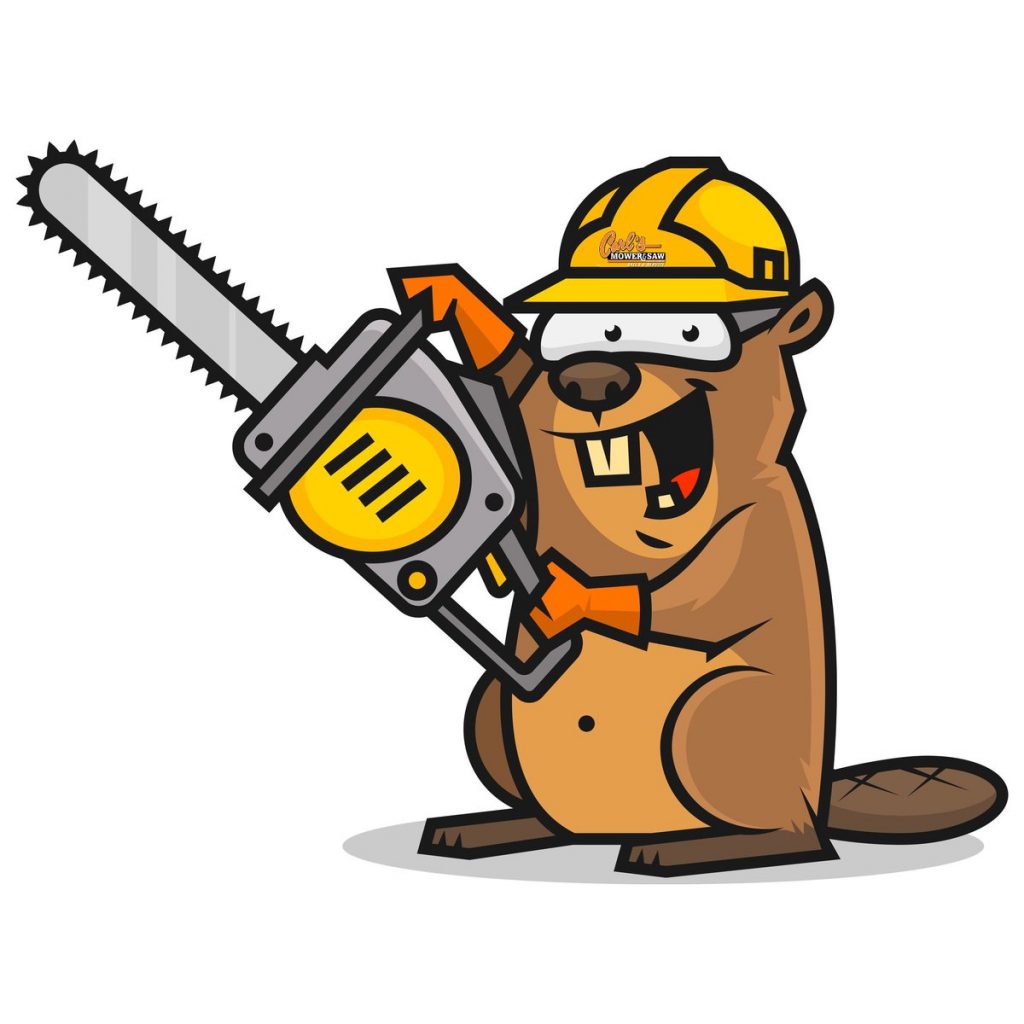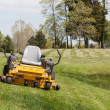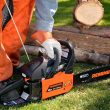Table of Contents
Have you already purchased a chainsaw and want to use it for the first time? So, if you’re looking for a helpful guide on how to start an electric or gas-powered chainsaw, then this article is for you.
Chainsaws are handy tools, which will save your time and energy during household duties or emergencies. So, if you want to get acquainted with such sawing machine, you can take a look at our chainsaw detailed reviews to find a lot of fascinating information. If you have already bought one, pay attention to the quick guide on how to start battery powered, cord electric and gas or electric saw machines.
Safety precautions before starting the chainsaw

First and foremost, you need to keep safety in mind when dealing with a chainsaw. Accidents can happen at any time, so you need to know how to start the tool correctly. Look carefully at the following tips to keep you safe before chainsaw use.
Read the manual first
Before starting any chainsaw, you should always read the manual to acquaint yourself with the tool you have never used. Although every motor saw model is different, you can start your saw machine without too many problems by following the steps we have outlined.
Don’t forget to buy safety equipment!
Chainsaws’ chains are very sharp. Always wear your protective gear! These include:
- Helmet and hearing protection
- Goggles
- Protective footwear
- Chainsaw chaps
- Gloves
Keep your chain sharp
You must sharpen chainsaws often to cut quickly and safely. You’ll need a file to make it as sharp as a blade.
Check the chain tension every time
You must make sure that the chain is tensioned correctly on the bar before activating the chainsaw. If the tension is too loose, the chain can fly off the motor saw and injure you, or if it is tight it may not move at all. Each saw machine has a specific procedure for tensioning such an important metal part, so read the owner’s manual.
Fill the bar and chain oil reservoir
Without lubricant, the speed at which the chain moves over the chainsaw bar can cause some serious friction that could do significant damage to your saw. It’s necessary to make sure that the bar and chain oil reservoir is full to have enough lubrication for your cutting job. Fill the store with exactly that oil that has been recommended in the manual.
Avoid kickbacks
Kickback occurs when the chain’s blade unexpectedly gets thrown back at you. It can cause serious cutting injuries. Rotational, linear, and pull-in are the most common types of kickbacks.
- Rotational kickback happens when the tip of the chain nicks a hard object. Never touch the bar’s tip and chain assembly to any wood or other things to avoid this type of kickback.
- Linear kickback occurs most often when your cut is not supported on both sides. A way to avoid it, make sure the wood you’re cutting is correctly balanced between the cut you’re making and the end of the wood.
- Pull-in kickback happens when your chainsaw hits something inside the wood, such as a nail. To prevent it, you had better know the wood being cut and how it has been previously used.
How to Start the Gas and Electric Chainsaws
Now that you have taken all safety measures, your chainsaw is ready for use. Take into account gas-powered models have a notably different and more time-consuming starting process than electric chainsaws.

Step 1: Place the chainsaw in the safe position
Place the saw on a solid, flat surface. Make sure the bar is away from any obstacles. Also, you should be positioned behind the chainsaw blade rather than in front of it. Hold the top handle with your left hand while using your right foot to hold down the back handle.
Step 2: Remove the bar cover
Remove the protective plate that covers the chain and bar.
Step 3: Engage the chain brake
Before starting your chainsaw, the chain brake should be activated by pushing it forward until you hear a click. The mechanism stops the metal cord from spinning and engaging it will help keep you safe.
🎉 Congratulations, your chainsaw is ready to go!
If you have the gas sawing machine, you need to take a few more steps described below to start your tool with both cold and warm engines.
If you have battery-powered or cord electric chainsaws, draw your attention here.
Starting a cold engine:

Step 4: Press the decompression valve (not for all models)
If your chainsaw is fitted with a decompression valve, press it now. It assists with firing the engine and starting your sawing machine.
Step 5: Turn the chainsaw on
It’s so basic, but it happens: make sure the On/Off switch is set to On when you start it.
Step 6: Prime the carburetor
Most gas-powered chainsaws have a fuel pump or air purge valve that you depress with your finger. If your motorized saw has one, press it several times to release fuel into the carburetor.
Step 7: Activate the choke
If you are starting your chainsaw cold, you need to use the choke. If your sawing machine doesn’t have one, you can ignore this step. Activate the choke by moving the lever to the full/half throttle position and pull the starter rope 3 or 4 times to start the engine.

Step 8: Pull the starter rope
Slowly pull the starter rope with your right hand until you feel resistance. Then make such a procedure several times until the engine fires briefly. You should pull the cord straight up in a vertical motion. Do not wrap it around your hand.
Step 9: Close the choke
If the engine runs for a moment and then dies, move the choke lever to the halfway position. Pull up on the starting cord again. The engine should start and idle. If it doesn’t run, pull it up several more times.
Step 10: Let the chainsaw idle and close the choke again
We recommend keeping the chainsaw at idle speed for a few seconds to warm up the engine. After idling time, move the choke lever to the closed position. The chainsaw should still be running.
Step 11: Release the chain brake
Release the chain brake by pulling its handle toward you with your left hand. Otherwise, the cord will not spin after starting. When you hear a click sound, this means the chain has been disengaged and can turn on the bar.
Step 12: Pull the throttle trigger
Good work! The saw is now ready for use. To start sawing, pull the throttle trigger with the index and middle fingers of your right hand.
Starting a hot engine:

You should know how to start a warm engine if you take a break during sawing or if you need to refuel your tool. The chainsaw starts without the choke when the engine is hot. Repeat the same steps as above, but omit the points relating to the throttle (steps 7,9,10).
Steps for battery-powered and cord electric chainsaws
Starting an electric chainsaw requires much less effort. You should follow only 7 steps to run your electric sawing machine: the first 3 that you can read here and the next 2 below.
Step 4: Plug the power cord into a power outlet or insert the battery (for battery-powered chainsaws)
Electric chainsaws require electrical power to operate. If you have a corded model, you’ll first need to connect to the power source, whether it be an extension cord or a generator.
For cordless models, you will want to make sure the battery is fully charged before use, and then just insert it in the chainsaw.
Step 5: Start the chainsaw
Now it’s time to operate your chainsaw! Push and hold a safety lock button for a while. When you engage the stop lock, pull the trigger to activate the spinning of the chain. Then you should wait some time to let the oil lubricate the metal mechanism. Remember to use both hands to hold the device.

Summary
Now you know how to start both gas and electric chainsaws. We hope you enjoyed this guide. Keep these safety precautions in mind, and you will not face any problems when working with a chainsaw.
If you are still choosing a saw machine, we encourage you to check out our small chainsaw reviews. You will find the top-8 chain machines you can buy today. In addition to some key features, you will get tips on what to pay attention to when choosing the chainsaw that best suits your needs. Happy sawing!
FAQ
💪🏼 Why does my chainsaw pull so hard?
Here are some common causes why the sawing machine is hard to pull:
- The housing may be damaged
The most common challenge that people face when pulling a chainsaw – the damaged starter housing. You’ll need to buy a new one and put it in place so that the chainsaw can start without encountering any issues.
- The pulley system is stuck
The pulley system on your chainsaw can get damaged due to wear and tear. Examine it to try to determine what is wrong. If a part appears to be damaged, then the best solution is to replace it.
- The starter rope is stuck
It happens that the rope gets stuck when you tried to pull it. If this is the case, you can just buy a replacement cord and then put it on as instructed in the manual.
⌛️ How long can I run a chainsaw?
It depends on the type and usage of the chain machine. For instance, a gas chainsaw, on average, runs up to 40 min before you have to fill it up again. Most battery-powered chainsaws have a run time of up to 2 hours, but there are high-capacity power packs that will last much longer.
🕘 How often does my chainsaw need to be lubricated?
You should refill your chain oil every time you fill your gas if you have a gas chainsaw. If you have an electric one, you need to lubricate its bar and chain before each use. It helps with the efficiency and life of the chainsaw.
🔧 How can I detect that my chainsaw chain is broken?
- Chainsaw feels unbalanced when you use it
If you tried to balance your chainsaw’s cutting teeth and adjust the tension correctly, but the saw still doesn’t cut perfectly, then it’s time to replace the chain.
- The chainsaw no longer cuts the wood as well as before
If you have to compress the chainsaw to keep it stable manually, this is a sign that the chain has lost its ability to draw itself into the wood. To solve this problem, you can sharpen your metal cord or buy the new one.
- The sawing machine emits smoke, even when lubrication is good, and chain tension is correct
If there is some kind of smoke during cutting, even if lubrication and tension are correct, your chainsaw can’t cut the wood properly. Smoke is not a good sign, and you should stop cutting and replace your chain before continuing.
- Problems with chain tension
If you constantly adjust the tension, but it continues to loosen more than it should, you will need to find a chain replacement as soon as you can.
- Crooked cuts
When a chain reaches the end of its lifespan, the directions in which it cuts will become more jagged and crooked. If you experience this issue, you should replace the chain.





